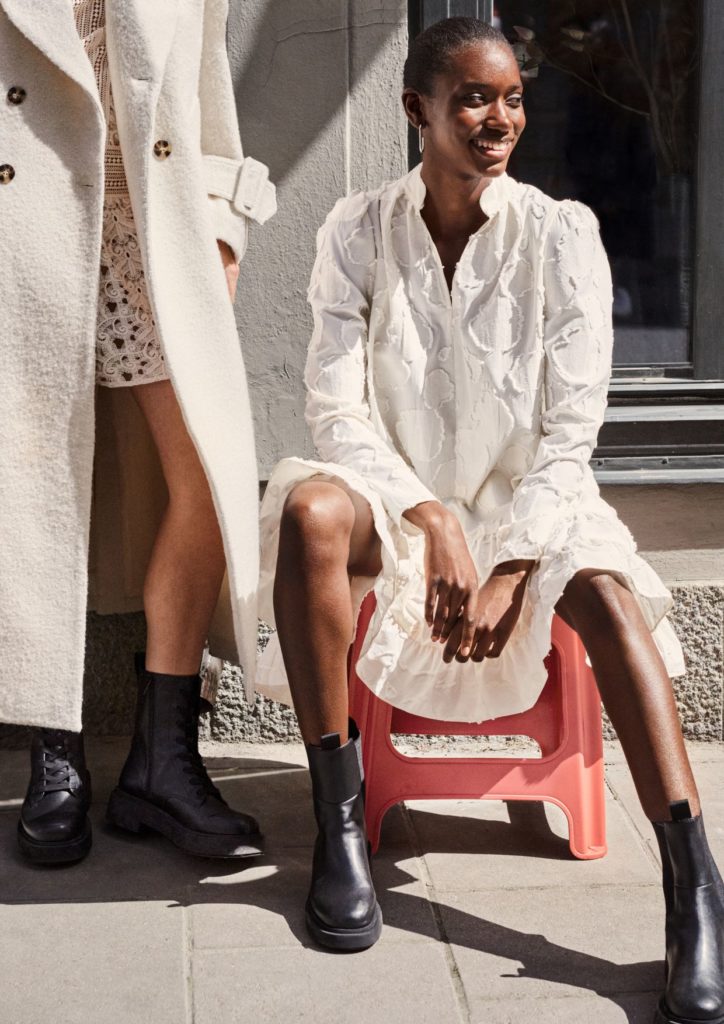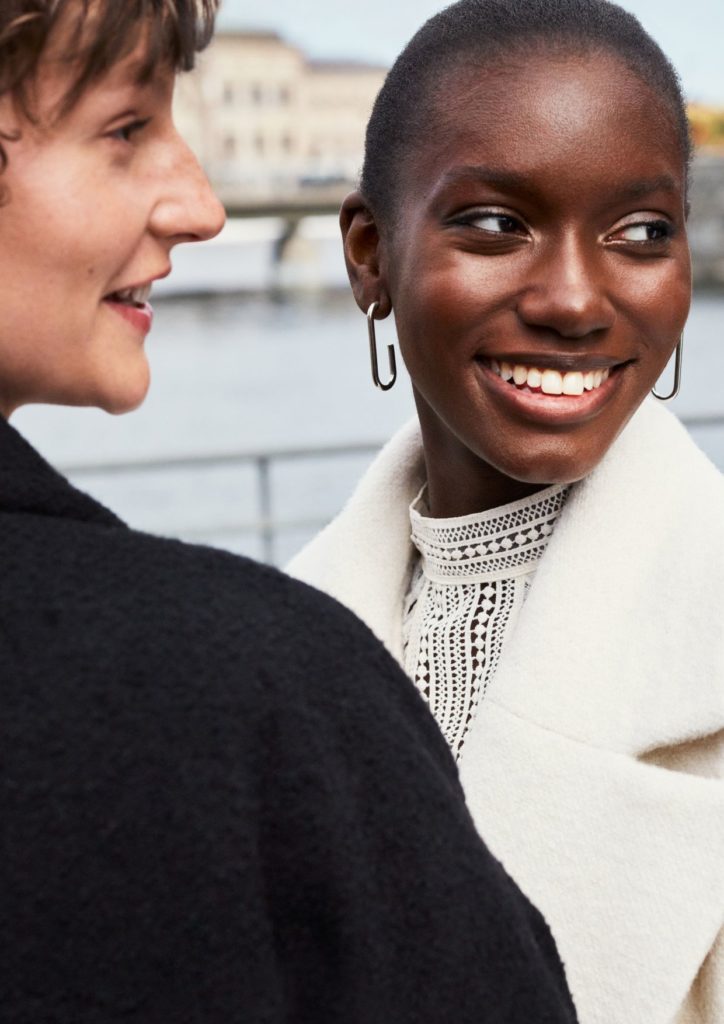H&M’s new CEO Helena Helmersson doesn’t believe that fast fashion should be a dirty word. “Having people all over the world be able to express themselves through fashion and design—that should be something beautiful,” she tells Vogue from the retail group’s Stockholm HQ, via Zoom. “The problem is that the system behind it needs to be changed.”
One thing that’s clear is that things can’t go on as they are. The current system involves the production of more than 100bn garments every year, with clothes being worn an average of just seven times before they’re thrown away, according to one survey. Clothing production is not only an enormous drain on natural resources, but also hugely polluting, with the fashion industry as a whole contributing up to 10 per cent of global CO2 emissions.

H&M’s sustainability credentials
As part of its bid to become more eco-friendly, H&M has set a target of achieving 100 percent recycled or other sustainably sourced materials by 2030, along with the ambitious goal of becoming climate positive by 2040. For Helmersson, it is the ultimate goal of moving to a 100 percent circular model—one in which all products can be reused or fully decomposed—that’s her main focus, although there’s still a long way to go before that can be achieved.
“How do you make sure that fibres can be used over and over again?” asks the CEO, who previously held the role of chief sustainability officer at the H&M group. “That’s the biggest need: to find better ways to scale up the recycling of fibres going forward.”
Some strides are being made in that direction. In February, H&M became the first retailer to sell a dress made from Circulose—a fabric that’s 100 percent recycled cotton—and sustainably sourced pulp. This month, the retailer also launched a new in-store recycling system called Looop, which allows customers to bring in their old garments and see them transformed into something new, right in front of their eyes. “With our size and our resources, we can be part of making [new technologies] more scalable,” Helmersson says of the company’s ability to drive change within fashion.

Addressing criticisms of ‘greenwashing’
It is H&M’s sheer size, however, that is a huge concern for environmental campaigners, who say the retailer’s business model—which requires producing and selling hundreds of millions of garments a year—is fundamentally unsustainable.
Helmersson argues that the company’s move to circular will mean it can “decouple growth and production of garments from the use of natural resources,” adding that the group is addressing overproduction. “We need to make sure that we produce what we can sell,” she says. “How can we forecast customer demand in better ways through tech and AI, so we don’t produce unnecessary volumes?”
The retailer has also faced accusations of greenwashing, with the Norwegian Consumer Authority describing H&M’s claims of sustainability in its Conscious collection “misleading” in 2019. (At the time, a spokesperson said that the company had “a good dialogue” with the authority “regarding how we can become even better at communicating the extensive work we do.”)
H&M’s Conscious collection is currently made from at least 50 percent sustainably sourced materials, such as organic cotton and recycled polyester, apart from in the case of recycled cotton, which currently only makes up 20 percent of a product due to quality restraints (although new technologies such as Circulose will aim to change that). However, the brand doesn’t currently give any specific details on the sustainable materials that each product contains, meaning customers aren’t able to assess the eco-credentials of the item they’re buying.
In spite of this, Helmersson says H&M is leading the way when it comes to transparency. Earlier this year, the company topped Fashion Revolution’s Transparency Index, which ranks 250 of the biggest global fashion brands and retailers according to how much they disclose about their social and environmental policies. “We’re taking a lot of steps when it comes to transparency, which I think is a fantastic way to engage with our customers,” she says.

The question of fair pay
In 2019, H&M introduced a new transparency layer on its website for each item, which tells you the production country, supplier and factory names, and number of workers in each factory. What’s still missing, though, is any information on workers’ pay. For many people, the question of how it’s possible that everyone in the supply chain is paid a fair wage, considering that a T-shirt costs as little as £3.99, remains a huge concern.
“We share suppliers with many other brands that take much higher prices, but the workers get paid the same regardless,” Helmersson responds. “Of course, for us it’s all about buying big volumes. You can get more productivity and better prices.” For her, making sustainable fashion affordable is a key part of H&M’s mission. “The price we have is amazing because then we can reach people, almost regardless of the size of their wallets, and help them in buying more sustainable fashion,” she adds.
There has been an increased spotlight on the treatment of garment workers during the pandemic, after an estimated $16bn worth of cancelled orders left suppliers struggling to pay wages. While H&M has honoured its orders, labour rights’ advocates have called for the company to make a concrete commitment to ensuring all workers in its supply chain are paid properly—with the Clean Clothes Campaign finding that 93 percent of brands still don’t pay a living wage to their suppliers.
In response, Helmersson says H&M is focused on changing the system. “We started with the Living Wage Initiative in 2013, which is about making sure that the factories we work with have the right systems in place to enable a fair living wage, so workers could negotiate their wage.” She goes on to argue: “We can’t set the wages ourselves, since we work with suppliers who employ the workers.”
However, the H&M CEO admits that more can be done. “It would be fantastic if we could, in the near future, see industry-wide minimum wages, but that demands a lot of collaboration with many other [brands],” she says. “Steps are being taken in the right direction. Is it going fast enough? No, I don’t think so.”
Helmersson—who spent two years working in the H&M production office in Dhaka, Bangladesh—is adamant, though, that H&M has a hugely positive impact in such countries. “A big company like H&M can be part of something truly amazing, especially when it comes to job creation, and especially for women [who make up approximately 80 percent of garment workers globally] and helping families out of poverty,” she says.

Plans for the future
Moving forward, Helmersson is focused on transforming H&M into a fully circular company that has a positive impact on the planet. Is she confident that she’ll be able to achieve that? “There has to be a completely different pace going forward,” she says, admitting that she doesn’t yet have all the solutions. “You can’t wait until you have all the answers to set the bold targets; you need to have the courage to set [them].”
What’s clear is that Helmersson is determined for H&M to continue being a leader on sustainability within the industry, with the CEO set to make her first major public appearance in her new role during the Copenhagen Fashion Summit—an annual gathering of the industry’s leading figures to discuss sustainability—this month.
“What I’m most passionate about is the reach that we have, and how we can make sustainable fashion accessible for all,” Helmersson concludes. “That, and leading the industry to a sustainable future.” Will she succeed? Only time will tell.





